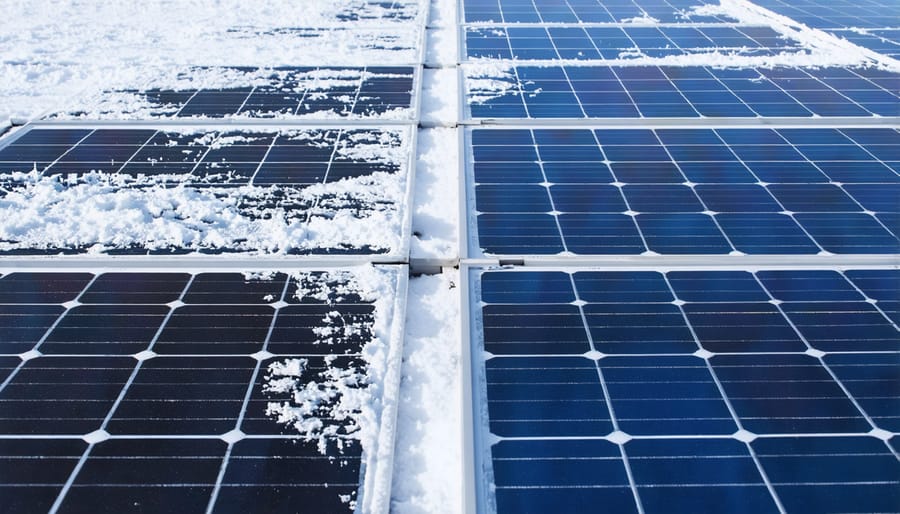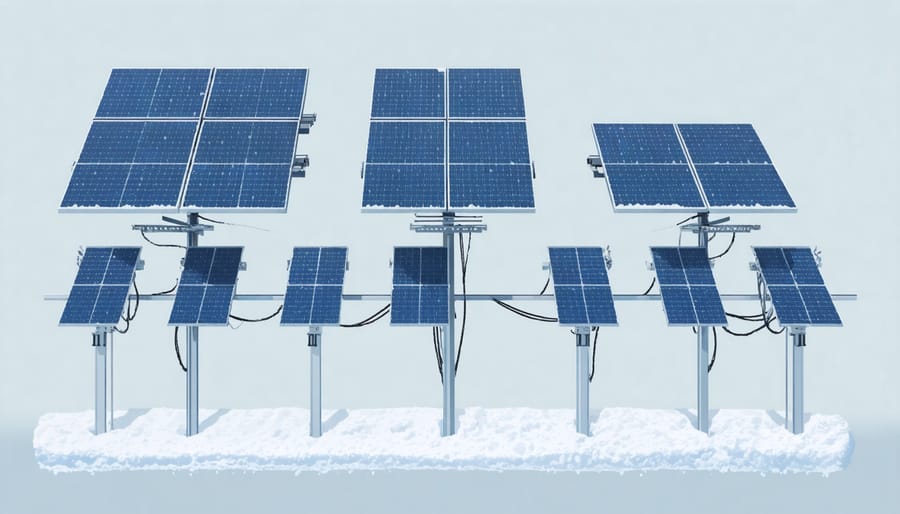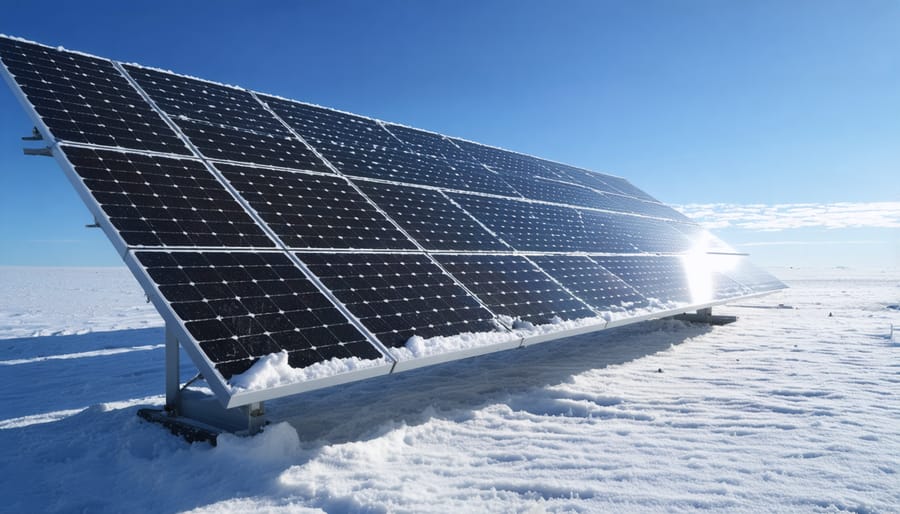Keep Your Solar Panels Snow-Free: Smart Solutions for Winter Performance
When winter blankets your solar panels in snow, your clean energy investment faces a crucial challenge. Snow-covered panels can reduce energy production by up to 90%, but this doesn’t mean your solar system becomes useless during the cold months. Smart homeowners are discovering that proper snow management can maintain impressive solar efficiency even in the harshest winters.
The relationship between snow and solar panels is more nuanced than many realize. While a light dusting often melts quickly due to the panels’ dark surface and residual heat, heavy accumulation requires careful attention. Modern solar installations are engineered to handle snow loads, but maximizing winter performance demands a balance between natural clearing and safe removal techniques.
For property owners investing in solar energy, understanding snow’s impact on panel performance isn’t just about maintaining energy production—it’s about protecting a valuable asset while ensuring year-round sustainability. Whether you’re considering solar for your home or already have panels installed, knowing how to handle snow accumulation can make the difference between frustrated winters and optimal energy generation throughout the year.
This guide will walk you through proven strategies to manage snow on your solar panels, ensuring you get the most from your renewable energy system during every season.
How Snow Impacts Solar Panel Performance
Energy Production Loss
Studies show that snow coverage can significantly impact solar performance in winter, with energy production losses varying between 15% to 35% during snowy periods. A comprehensive study by the National Renewable Energy Laboratory found that snow-covered panels can experience complete power loss until the snow melts or is removed. However, these losses typically account for only 1-5% of annual energy production in most regions.
The good news is that modern solar installations are designed to handle snow loads, and the energy loss isn’t as severe as many homeowners fear. In fact, the white surface of snow can actually increase panel efficiency through the albedo effect, reflecting additional sunlight onto exposed portions of nearby panels. Research from Northern Alberta Institute of Technology demonstrates that panels installed at a tilt angle of 45 degrees or greater naturally shed snow faster, reducing production losses by up to 25% compared to panels mounted at lower angles.

Weight and Structural Considerations
When installing solar panels in snowy regions, it’s crucial to ensure your roof can handle both the weight of the panels and accumulated snow. A standard solar panel system adds about 2-4 pounds per square foot to your roof’s load, but snow can add significantly more weight – potentially 20-25 pounds per square foot when packed.
Before installation, have a qualified structural engineer assess your roof’s load-bearing capacity. They’ll evaluate factors like roof age, construction materials, and local building codes to ensure safe installation. Many modern homes are built to handle substantial snow loads, but older structures may need reinforcement.
Pay special attention to how snow accumulates around panel mounting hardware. Quality mounting systems include additional support points to distribute weight evenly across roof trusses. Consider installing snow guards above panels to prevent dangerous snow slides, which can damage gutters or create hazardous conditions below.
Remember that panels installed at steeper angles (40-60 degrees) typically shed snow more effectively while reducing the overall weight burden on your roof structure. This natural clearing ability helps maintain system efficiency while ensuring structural safety.
Effective Snow Removal Methods
Passive Solutions
Nature has provided several elegant solutions for managing snow on solar panels, and understanding these passive approaches can help maximize your winter solar efficiency. The most effective passive solution lies in proper panel installation angle. When panels are installed at a steeper angle (typically 35-45 degrees in snow-prone regions), snow naturally slides off as it accumulates, using gravity to your advantage.
Many modern solar panels feature self-cleaning surfaces with special coatings that reduce snow and ice adhesion. These hydrophobic coatings work similarly to rain-repelling treatments on car windshields, making it harder for snow to stick and easier for it to slide off when temperatures rise slightly.
The dark surface of solar panels also assists in snow removal. As sunlight penetrates through even thin layers of snow, the panels absorb heat and create a slight warming effect. This natural heating helps create a thin layer of water between the snow and panel surface, facilitating natural sliding.
Panel placement can also make a difference. Installing panels in areas that receive maximum winter sunlight and avoiding shade from nearby trees or structures ensures better passive snow clearing. Some installations incorporate a smooth panel surface transition, eliminating gaps or obstructions that might trap snow and prevent natural clearing.
Active Removal Techniques
When it comes to actively removing snow from your solar panels, using the right tools and techniques is crucial for both safety and panel protection. A telescoping snow rake with a soft foam head is the most recommended tool, as it allows you to clear snow while maintaining a safe distance from the panels. These specialized rakes have smooth edges that won’t scratch or damage the glass surface.
For lower-mounted panels, a soft-bristled brush with an extended handle can be effective. Always brush in the direction that snow would naturally slide off to prevent snow from accumulating at the bottom edge. Never use metal tools, sharp objects, or regular snow shovels, as these can scratch or crack the panels.
Hot water should never be used for snow removal, as the sudden temperature change can crack the glass. Similarly, avoid using rock salt or chemical de-icers, which can corrode the panel framework and mounting hardware.
If you decide to remove snow manually, always work from the ground when possible. If roof access is necessary, ensure proper safety equipment is used, including non-slip boots and a safety harness. Remember that wet solar panels can be extremely slippery, so it’s often better to wait for safer conditions or hire a professional.
For commercial installations or hard-to-reach panels, consider investing in a professional snow removal service that specializes in solar panel maintenance. They have the right equipment and expertise to safely clear snow without risking damage to your investment.

Automated Systems
Automated systems offer a hassle-free approach to managing snow accumulation on solar panels. These solutions typically include heating systems that prevent snow buildup and automated cleaning mechanisms that keep panels operating at peak efficiency during winter months.
The most popular automated solution is the panel heating system, which uses a network of heating elements installed beneath or within the solar panels. These elements activate automatically when sensors detect snow accumulation or freezing conditions, maintaining the panel surface at a temperature that prevents snow from sticking.
Many modern heating systems are surprisingly energy-efficient, using only 5-10% of the energy that the panels generate. They can be programmed to activate based on specific weather conditions, ensuring they only operate when necessary. Some advanced systems even incorporate weather forecast data to prepare for incoming snowfall.
Another innovative solution is the automated brush system, which uses weather-resistant mechanical brushes that sweep across panels at scheduled intervals. These systems are particularly effective for commercial installations where manual cleaning isn’t practical.
While automated systems require a higher initial investment, they often pay for themselves through reduced maintenance costs and improved winter energy production. Many property owners report 20-30% better winter performance after installing automated snow management systems, making them an attractive option for regions with heavy snowfall.
Remember that professional installation is crucial for these systems to function properly and maintain your panel warranty. Regular maintenance checks ensure optimal performance throughout the winter season.
Preventive Measures and Installation Tips
Optimal Panel Positioning
The key to minimizing snow accumulation on your solar panels starts with optimal solar installation design, particularly when it comes to panel positioning. The ideal angle for snow shedding is typically between 35 and 45 degrees, which allows gravity to work in your favor. This steeper tilt helps snow slide off naturally while maintaining good solar energy production throughout the year.
For regions that experience heavy snowfall, considering a slightly steeper angle of up to 45 degrees can be beneficial, even if it means a small sacrifice in summer energy production. The panels should face true south (in the Northern Hemisphere) to maximize both sun exposure and snow-shedding capabilities.
Installation height also plays a crucial role. Mounting panels higher on the roof creates more space for snow to slide off without building up at the bottom edge. Additionally, leaving adequate space between panel rows prevents snow from becoming trapped and compacted between them.
Consider installing a smooth surface treatment or snow guard system that promotes controlled snow sliding. These systems help prevent sudden avalanches while maintaining steady snow removal. Some modern mounting systems even include heating elements along the panel edges to facilitate snow melting at critical points.
Remember that local climate conditions should influence your final positioning decisions. Consulting with a local solar installer familiar with regional weather patterns can help optimize your setup for both snow management and energy production.

Maintenance Schedule
To keep your solar panels performing optimally during winter, establishing a regular maintenance schedule is crucial. Start by implementing these winter maintenance solutions before the first snowfall:
Monthly Tasks:
– Inspect panels for any damage or loose connections
– Check monitoring system for performance issues
– Clear debris from panel surfaces
– Verify snow guards are properly secured
Weekly Tasks During Snow Season:
– Monitor snow accumulation levels
– Document panel performance
– Clear heavy snow using appropriate tools
– Check drainage systems around panels
Daily Tasks During Active Snowfall:
– Observe snow buildup patterns
– Monitor panel output
– Clear access paths to panels
– Record weather conditions
Remember to schedule professional inspections twice during winter: once before the season begins and another mid-season. This helps identify potential issues before they become major problems. Keep a maintenance log to track patterns and optimize your snow management strategy.
Pro tip: Set weather alerts on your phone to prepare for incoming storms. This allows you to implement preventive measures before heavy snowfall, making maintenance easier and more effective. Consider installing a remote monitoring system to track panel performance without climbing onto your roof during hazardous conditions.
As we’ve explored throughout this article, managing snow on solar panels is crucial for maintaining optimal energy production during winter months. The good news is that with the right approach and tools, you can effectively handle snow accumulation while protecting your investment in clean energy.
Remember that while snow can temporarily reduce solar panel efficiency, most systems are designed to handle winter conditions. The combination of panel tilt, natural melting, and proper maintenance usually ensures your system continues producing energy throughout the season. However, taking proactive steps can significantly improve your panels’ winter performance.
Key takeaways for successful snow management include:
– Investing in quality mounting systems that provide adequate tilt for natural snow sliding
– Installing snow guards when necessary to protect areas below panels
– Using appropriate snow removal tools designed specifically for solar panels
– Following safety protocols and considering professional help for challenging situations
– Monitoring system performance through your inverter or monitoring app
Many solar panel owners find that a balanced approach works best – allowing natural melting when possible while being prepared to safely remove snow during heavy accumulation. This strategy helps maximize energy production while minimizing risk to both the equipment and yourself.
Looking ahead, consider implementing some preventive measures before next winter. This might include scheduling a professional inspection, upgrading your monitoring system, or installing heating elements if you live in an area with frequent heavy snowfall.
Remember that your solar investment is a long-term commitment to sustainable energy. By maintaining your panels properly during winter months, you’re not just protecting your investment – you’re ensuring consistent clean energy production for years to come. Stay proactive, prioritize safety, and enjoy the benefits of solar power through every season.








